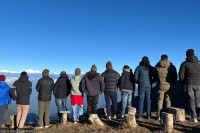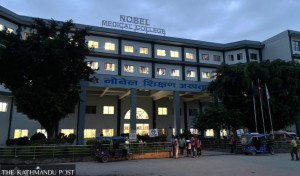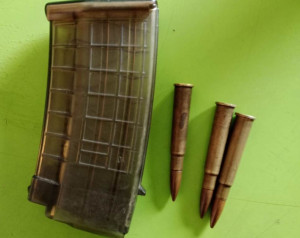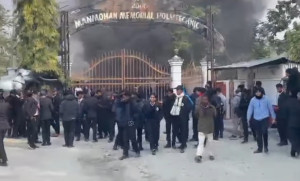Koshi Province
Food prices shoot up in Kanchenjunga area as Topethok-Ranipul road gets obstructed
With no vehicles to import goods, the local grocers and hoteliers have hired porters and Chauri to carry the load.
Ananda Gautam
Juneli rice, a popular brand of rice in the Kanchenjunga area, is cooked in almost all the kitchens in the area. The market price of a 30-kg pack of Juneli rice is Rs 1,750 in Phungling, the district headquarters of Taplejung. But the same pack of rice costs Rs 7,000 in Khabachhen, Pangpe, Selele, Oktang, Rajmer and Cheiram of the district.
According to wholesalers in Phungling, more than 90 percent of people consume Juneli rice in the hilly areas of Kanchenjunga. And the poor condition of roads in these rural villages has led to an expensive price tag on food products, including Juneli rice, transported to these villages.
The monsoon this year, like every other year, triggered several landslides along the Topethok-Ranipul road section, obstructing vehicular movement. With the monsoon slowly retreating, vehicles have gradually begun reaching up to Linkhim, 31-km from Phungling. From there, goods have to be transported on foot by porters or on Chauri for up to 10-km.
The villagers usually take the foot trails in Tamor, Ghunsa, Hellok, among other areas, when the Topethok-Ranipul section is blocked. But this year, even the foot trails have been blocked due to landslides.
“As we only grow potatoes here, we have to purchase rice from local grocers,” Mingma Tenzing Sherpa, a local of Khambasen, said. “We don’t have a Nepal Food Corporation depot in Ghunsa, so we have to pay a high price to get rice in the local market. The prices go up especially during monsoons when transportation services are disrupted.”
With no vehicles to import goods, the local grocers and hoteliers have hired porters and Chauri to carry the load. Nupu Sherpa, manager at Kanchenjunga White House, a guest house in Ghunsa, said that porters charge Rs 150 (per kg) to carry rice from Phungling to Ghunsa.
Lila Chakra Gurung, the headmaster of Ghunsa Basic School, said that locals in the high hills such as Khabachhen, Pangpe, Selele, Oktang, Rajmer and Cheiram use Chauri to carry goods.
In the past, residents of Ghunsa and other hilly areas purchased rice from a depot of Nepal Food Corporation at Linkhim in Phaktanlung Rural Municipality. But the depot was shut down almost two decades ago. Now there’s only one depot in Phungling, which is not sufficient for the people of the region.
“We have been asking the concerned authority to open NFC depots in remote villages so we don’t have to depend on a sole depot for supplies,” he said.
Himali Chungda, a local man, said that the government has failed to take stock of the situation in the hilly villages.
“High-level government officials don’t visit our village. They don’t know our situation,” said Chungda. “If they came here, they would see the price we have to pay for a kilo of rice.”
Since the area is frequented by visitors, mostly trekkers, hoteliers say they have a hard time providing food at a reasonable price. Mingmadandu Sherpa, who runs a hotel in Linkhim, said, “We have to transport daily essentials, including rice and vegetables, from the district headquarters. We incur high costs; therefore, a plate of a vegetarian meal is priced at Rs 500. We know it’s expensive, but we also have to pay a lot to get food essentials transported here.”
Tikaram Gurung, chairman of Sirijangha Rural Municipality, said that the municipality has opened a road track up to Yamphudin, near Kanchenjunga Base Camp.
“We will take initiatives to upgrade the Topethok-Ranipul road section this fiscal year,” Gurung said.
However, he added that the upgradation of the road section would not ensure road connectivity, given the fragility of the topography that is prone to landslides during monsoons.




 19.12°C Kathmandu
19.12°C Kathmandu















